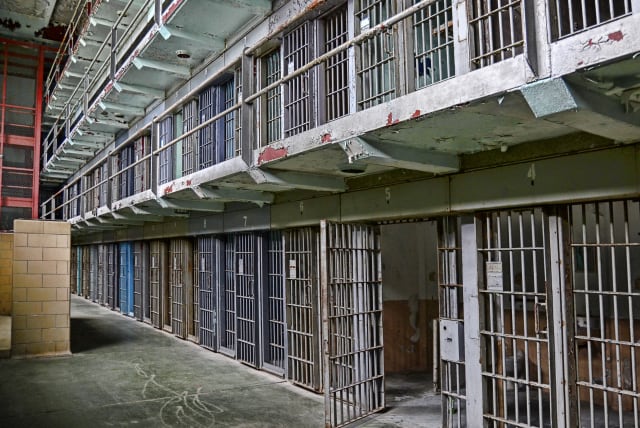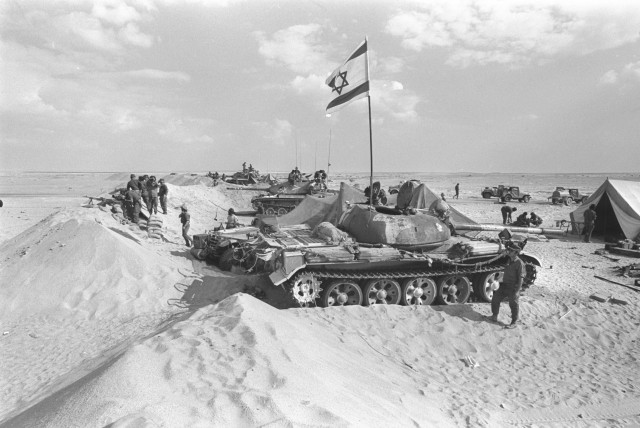The Yom Kippur War inside Abbasiya Prison

The day marked the beginning of a harrowing journey through captivity that would last for more than three years, including the tumultuous period of the Yom Kippur War.
With Israel’s existence on the line during the Yom Kippur War, Jeff Peer “sat that one out.” Already a POW for over three years, he was incarcerated in a large room in Egypt’s Abbasiya prison in Cairo with eight other Israeli captives, watching the war via the propaganda-laced TV channel Voice of Cairo. Not knowing his fate but a useful political pawn to the Egyptians, Peer faced an uncertain future but with enduring hope for his eventual release
Born in the United States, Peer immigrated to Israel in 1957 at the age of 14, along with his brother and his mother, a pharmacist who raised him as a single parent. Growing up in Kibbutz Mizra near Afula, Jeff had his destiny set in motion when he was accepted into the Israeli Air Force and earned his wings in 1963. He tasted combat during the Six Day War in a Mirage Fighter, where he flew combat missions to ensure Israeli aerial superiority. He described the experience of knocking out the Arab air forces as one that was “exceptional, being well planned, rehearsed, and perfected.” Following the war, and the elated feeling that followed, the United States lifted its military embargo on Israel, and Peer advanced to the F4 Phantom, becoming one of the first Israeli pilots to train for combat on this formidable aircraft.
On June 30 1970, as the War of Attrition was raging over the Suez Canal region, Peer found himself in the cockpit of an F4 Phantom, ready to undertake a mission that would forever change the course of his life. Alongside his co-pilot, Yair David, they were tasked with attacking an SA2 missile air defense site, a mission of utmost importance to maintain Israel’s air superiority in the region
As their aircraft climbed to 20,000 feet, an unexpected turn of events thrust Peer into a life-altering ordeal. Two missiles, descending from an unusual angle, locked onto their aircraft, leading to evasive maneuvers and two explosive impacts that reverberated through the cockpit. Despite the chaos unfolding around them, the resilient pilots managed to release their missiles toward the designated target below. However, the relentless assault continued, as a third missile, likely an SA3, raced toward them. In a desperate effort to survive, Peer released the fuel tanks just moments before a deafening explosion tore off the tail of their aircraft. With his navigator safely ejected, Peer’s own ejection system refused to release, leaving him trapped in a rapidly disintegrating aircraft.
Peer explained the situation this way: “This aircraft was falling out of the sky, smoke and flames were all around me. Was waiting for the ejection seat. Waiting for the canopy. Out of the corner of my eye I saw puffy clouds, indicating I was already very close to the ground, so I manually detached from the seat, pushed the canopy open, and manually opened the parachute. The airplane became a hole in the ground with exploded ammunition.”
He remarked later with a smile that he may have been one of the only pilots ever to eject manually out of a F4 and survive.
A prisoner of war in Egypt
Landing on Egyptian soil, Peer was now a prisoner of war, captured by the Egyptian military. The day marked the beginning of a harrowing journey through captivity that would last for more than three years, including the tumultuous period of the Yom Kippur War.
The Yom Kippur War unfolded with a backdrop of uncertainty for Peer and his co-captives at Abbasiya. They had access to limited information through a single television channel, Voice of Cairo, when the war started, Peer elaborated. “We had access to some outside information and we heard sirens. There were lots of sirens. The TV started to blare songs and Egyptian rhetoric talking about the ‘Great War that will enable Egypt to capture all of Israel.’”
As the war started, Peer and his fellow captives were separated from each other and placed in individual cells. They began to hear the sounds of other Israeli prisoners and soon realized that more compatriots had been captured. As the Egyptians feared collusion among the captured Israelis, “We were put back in our room so we wouldn’t be able to affect those prisoners,” he explained.
Back together, the Israeli captives observed the images of Egyptian forces crossing the Suez Canal on television. The situation looked dire; but then new footage stopped appearing on the television screen, becoming one continued loop. “We somehow learned from other sources that things were not progressing for the Egyptians.. We figured that Israel will indeed be victorious. So there is a good chance that we will be repatriated,” he said.
Surviving in the confines of Abbasiya Prison required strong mental resilience. Peer and his fellow captives believed they had three potential paths to freedom: peace between Israel and Egypt; a miracle; or an exchange of prisoners through war. As the years passed, hope of the first two options waned, leaving the possibility of a future conflict as their beacon of hope.
During their captivity, Peer and his comrades distinguished themselves by wearing their own clothes instead of Egyptian prison uniforms, convincing the Egyptians to allow them to do so as they absolutely refused to wear the common prison uniform.
“The only uniform we wear willing to wear was our IAF one. The Egyptians understood this, and of course they wouldn’t allow us to wear our Israeli uniforms so they allowed us to wear our own clothes instead,” Peer reflected.
Additionally, they received a food allowance through a fund established within the prison system channeled by the Red Cross, providing them with some measure of comfort amid their grim circumstances.
To stave off despair and maintain a sense of purpose, the Israeli POWs created a tight-knit community within the confines of their shared room. They established a makeshift classroom where they taught each other various subjects, such as English, Math, and Bible study. Peer took on the role of an English instructor, as it was his mother tongue. With a touch of humor, he noted, “We had two different streams – advanced and more advanced. There was no ‘beginners,’ as it didn’t sound right to the group,” he said.
Remarkably, amid the challenges of captivity, they embarked on an ambitious project — translating J.R.R. Tolkien’s The Hobbit into Hebrew. The inspiration for this endeavor came from a gift Peer received from his brother through the Red Cross — a copy of The Lord of the Rings trilogy. Recognizing the potential for distraction and solace in Tolkien’s epic, Peer and his fellow captives embarked on the monumental task of bringing The Hobbit to life in their own language.
The translation project involved four individuals – Avi, Rami, Menahem, and Peer (Yitzhak in Hebrew). Not being Israeli-born and possessing less fluent Hebrew, Peer read the English text aloud, while Avi transcribed and discussed the content. Menahem and Rami meticulously combed through the text, ensuring grammatical correctness, while Rami tackled the challenge of translating the poems found within the book. This collaborative effort spanned a year, offering a sense of purpose and a connection to the outside world.
After enduring over three years of captivity, marked by uncertainty, the Israeli POWs received a glimmer of hope. The Red Cross paid them a visit, and news of the Yom Kippur War’s end reached their ears. Simultaneously, discussions regarding the exchange of prisoners began. “We heard the war was over. We heard that there were talks about prisoners of war. Israel had 12,000 because Arik Sharon captured the entire Egyptian 3rd army when he crossed the canal,” Peer reflected. The Red Cross, aware of Peer and his group’s protracted ordeal, prioritized their release. However, the Israeli POWs, in an act of solidarity, insisted that the newly wounded be the first to return to Israel.
As Peer recounted, “We have our little room; we can stay here for a little longer. We did it for three and a half years, we can do it a while longer.” And so, the wounded were repatriated first.
November 16, 1973, marked the day of Jeff Peer’s long-awaited return to Israel. Blindfolded and dressed in the clothes they had carefully set aside for this moment, Peer and his fellow POWs were transported to Cairo’s airport, where they boarded an airplane bound for Tel Aviv.
As they disembarked from the plane in Tel Aviv, they were greeted by a sea of people—military personnel, high-ranking officials including Moshe Dayan and Golda Meir, and family members who had yearned for this moment for years. The commander of the Israeli Air Force personally welcomed them, walking onto the plane and helping them disembark.
For Peer, the reunion was deeply personal and a sense of bewilderment: “It was extremely emotional to see my family, people who were my squadron mates, no one said anything about the Yom Kippur War when we landed. We were totally in the dark about how difficult and how costly the war was for the State of Israel. We were in our own little world, our own bubble.”
Peer’s return to Israel was a homecoming filled with mixed emotions. As he observed the changes in Israel that had occurred during his captivity, he couldn’t help but sense an overtone of sorrow in the nation. The toll of the Yom Kippur War had been immense, with a staggering number of casualties and a battered Israeli Air Force. The returning POWs were shielded from this grim reality. “Only when we started asking questions did they tell me,” he recalled.
Nonetheless, within the Israeli Air Force, there was a steadfast unified commitment to the mission. “Everyone seemed much more serious,” Peer said as he described an encounter with prominent newscaster Dan Shilon, who asked him how it felt to risk their lives while others enjoyed the comforts of daily life. Peer’s response captured the essence of their dedication: “That’s why we do it. We risk our lives so that you can have your coffee on Dizengoff in peace.”
In closing, Peer offered a poignant message for modern Israel, reflecting on the collective spirit he felt both in captivity and after the war. Despite the divisions and polarization that plague society today, he emphasized the importance of dialogue and, more importantly, listening. Drawing from his experiences as a POW, he highlighted the strength of unity in the face of adversity.
“For myself, I know what is going on in Israel now. I have children and grandchildren in Israel. The divisiveness and polarization I feel pains me very much. I can’t tell people what to do. But we have drifted apart. If we can pull through hardships and divisiveness...there were religious, and more secular, Right wing and Left wing when we were together. We all got along. We managed to talk things through. I think, I hope, that talking can help us. More than talking, I think it is listening today, and I see it here and in the US as well. We don’t listen to each other – we talk at each other. That isn’t a recipe for success.”
Despite his ordeal, Peer soon returned to the Israeli Air Force. He continued to fly combat missions, and additionally served as a test pilot and instructor in the flight academy, until his retirement in 1984. ■
Jerusalem Post Store
`; document.getElementById("linkPremium").innerHTML = cont; var divWithLink = document.getElementById("premium-link"); if (divWithLink !== null && divWithLink !== 'undefined') { divWithLink.style.border = "solid 1px #cb0f3e"; divWithLink.style.textAlign = "center"; divWithLink.style.marginBottom = "15px"; divWithLink.style.marginTop = "15px"; divWithLink.style.width = "100%"; divWithLink.style.backgroundColor = "#122952"; divWithLink.style.color = "#ffffff"; divWithLink.style.lineHeight = "1.5"; } } (function (v, i) { });

